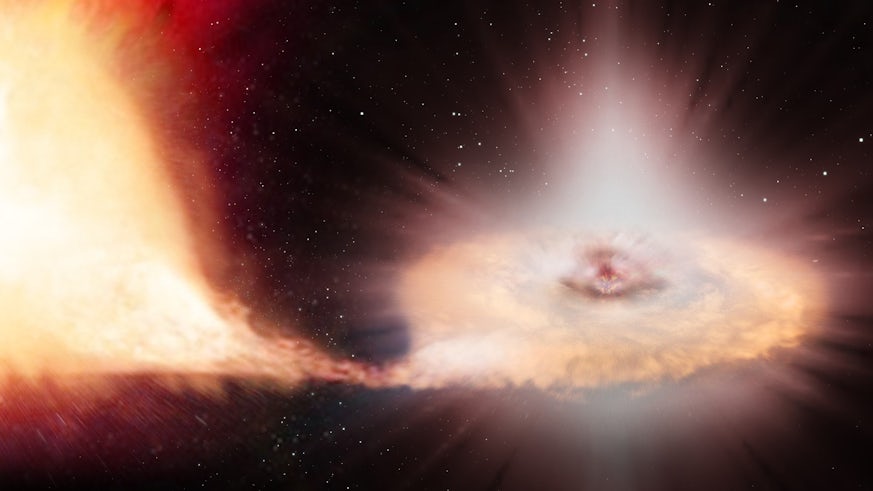Astronomers uncover previously unknown source of star dust in rare supernova explosion
12 February 2024

The first clear evidence of freshly baked star dust in a Type Ia supernova has been observed by an international team of astronomers.
Monitored over the first three years after its explosion, the team claim the supernova – based in a spiral galaxy around 300 million lightyears away – is one of the most prolific dust-producing supernovae ever recorded.
Their findings reveal an entirely new source for the tiny particles of cosmic matter thought to be the building blocks of planetesimals, and ultimately rocky planets and even life across the universe.
Until now researchers had focused their search for these so-called dust factories on Type II supernovae, massive stars which explode at the end of their short lives through a process known as core collapse.
The new study, published in Nature Astronomy, focuses instead on SN2018evt, a Type Ia supernova.
More frequent than Type II, these typically originate from binary star systems containing at least one white dwarf – the small, hot core remnant of a Sun-like star with roughly the size of Earth.
Professor Haley Gomez, Head of Cardiff University’s School of Physics and Astronomy and one of the study’s co-authors, said: “One of the fundamental questions in astronomy is: what types of stars form dust? We thought we had a pretty good answer to this until ESA’s Herschel Space Observatory hinted at the existence of some puzzling elliptical galaxies around ten years ago.

Sometimes called red and dead or zombie galaxies, ellipticals are different to spirals like the Milky Way – they are made up of swarms of stars and they do not have core-collapse explosions – and yet Cardiff astronomers discovered a whole host that were extremely dusty. Our new study on SN2018evt shows that only 1,041 days after the explosion, a huge amount of cosmic dust was formed, equivalent to one percent of our Sun’s mass. This may offer an explanation for the abundance of dust we see in these strange elliptical galaxies.
Astronomy Group
Cardiff Hub for Astrophysics Research and Technology
The team monitored SN2018evt for three years using a combination of space-based telescopes including NASA’s Spitzer and NEOWISE missions, and ground-based facilities like the Las Cumbres Observatory’s global network of telescopes, as well as others in China, South America, and Australia.
Combining the data from these instruments meant the team were able to prove that the infrared “glow” from the dust was getting brighter, from the early aftermath of the supernova explosion until 1,000 days later. Another tell-tale sign of dust formation was the dimming of the visible light from SN2018evt as the freshly baked dust began to act as a smokescreen.
They found the supernova formed brand new dust as its thermonuclear shock wave crashed into the material previously cast off by one or both stars in the binary system before the white dwarf star exploded.
Professor Gomez added: “Rather than highlighting an oversight in our understanding of Type Ia supernovae, our study shows that the explosive material from the Ia needs to interact with a companion, in this case a red super giant in order to create a lot of dust.”
To make sure the dust was created by SN2018evt the team also needed data on the electromagnetic radiation emitted during the explosion.
Dr Cosimo Inserra, another of the paper’s co-authors based at Cardiff University’s School of Physics and Astronomy, said: “We used a technique called spectroscopy to examine chemical signatures, which are like the DNA of the explosion from the supernova.

This helped us figure out what kind of supernova it was, how it exploded, and how it was interacting with the material around it, which can take thousands of years to develop. It’s a process not unlike how candy floss is made, where the stellar material gets spun around dynamically time after time eventually creating a fluffy candy-like substance of cosmic gas around the supernova.
Deputy Director of Research
Associate Dean of Equality, Diversity and Inclusivity, College of Physical Sciences & Engineering
Gravity Exploration Institute
Cardiff Hub for Astrophysics Research and Technology
The team believes their calculations may not account for all of the dust produced by SN2018evt as it is likely to continue to grow over time, and hope observations from the James Webb Space Telescope’s near-infrared and mid-infrared instruments will detect yet more dust in the future.
Their paper, ‘Newly Formed Dust within the Circumstellar 2 Environment of SNIa-CSM 2018evt’, is published in Nature Astronomy.
Share this story
It is a friendly, approachable School with a strong commitment to teaching excellence and world class research in physics and astronomy.




